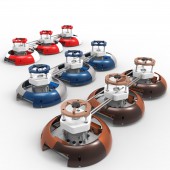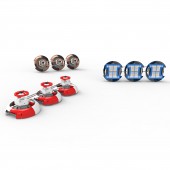DESIGN NAME:
Mantis
PRIMARY FUNCTION:
Facade Cleaning Robot
INSPIRATION:
Caterpillars are known for efficiently navigating over highly complex environments. Our Mantis robot derives inspiration from locomotion in caterpillars. The developed robot consists of three segments that utilizes impeller mechanism coupled with track wheels to navigate over vertical facades. The multi-segmented design allows the robot to overcome positive obstacles of a maximum height of 4cm and a maximum width of 8cm.
UNIQUE PROPERTIES / PROJECT DESCRIPTION:
Mantis is a new class of facade cleaning robots that are not only capable of autonomously navigating flat vertical facades but also move over positive obstacles and kerbs. To this end, Mantis is equipped with a caterpillar inspired linear actuator bar system which allows it to cross over obstacles on vertical facades with ease. Mantis is equipped with onboard sensors that enables creation of real time maps of the operating environment, health monitoring, and optimal cleaning paths.
OPERATION / FLOW / INTERACTION:
When the robot reaches a positive obstacle on the facade, linear actuators on the bar system activate, raising the bar, preparing the robot to cross the obstacle. The first impeller switches off and the first actuator activates, raising the first module. The robot then moves, making the module cross the obstacle. The module is lowered to the next facade, and its impeller is switched on. This process is repeated for the other modules until the entire robot has crossed over the obstacle.
PROJECT DURATION AND LOCATION:
This project is funded by National Robotics Programme Office, Singapore. The project started in August 2017, and will end in August 2019. This project aims to develop a new class of robots that target cleaning, maintenance and inspection of built infrastructures.
FITS BEST INTO CATEGORY:
Product Engineering and Technical Design
|
PRODUCTION / REALIZATION TECHNOLOGY:
The modules have track wheels to rotate and move on the facade. Each has an impeller, allowing the robot to stick on the facade. Each module is equipped with a microfibre cloth.
The passive rotary system is designed to bring the centre of mass close to the facade. It uses bearings to guide the system. Linear actuators are used to raise or lower the bar system or the modules.
Parts produced by 3D printing and laser cutting technologies. Materials include PLA and acrylic.
SPECIFICATIONS / TECHNICAL PROPERTIES:
Dimension: 1000mm (l) x 332mm (w) x 195mm (h)
Weight: 8kg
TAGS:
Facade cleaning, impeller, vertical obstacles, cleaning, surface robot, modular
RESEARCH ABSTRACT:
Although there are many robots designed to clean vertical facades, most of these robots are unable to cross over positive obstacles between vertical facades. While there are some robots being developed with such abilities, these robots either are slow or make use of highly complex mechanical systems. Mantis is developed with the aim of tackling this critical issue of navigating efficiently over positive obstacles while minimizing the complexity of the associated mechanism.
CHALLENGE:
One of the key challenges that we faced is the synthesis of a mechanism that allows the robot to move independently from the bar system. This requirement is further complicated due to size constraints and the need to make the centre of mass as close to the surface of the facade as possible.
ADDED DATE:
2018-02-08 09:15:58
TEAM MEMBERS (8) :
Tan Yeh Wen, Siti ‘Aisyah Binte Jailani, Mohan Rajesh Elara, Vengadesh, Sri Harsha, Thein Than Tun, Karthikeyan Elangovan and Ratnayake Mudiyanselage Tarindu Dakshin Abeysekera
IMAGE CREDITS:
Image #1: Vengadesh
Image #2: Vengadesh
Image #3: Vengadesh
Image #4: Vengadesh
Image #5: Vengadesh
|









